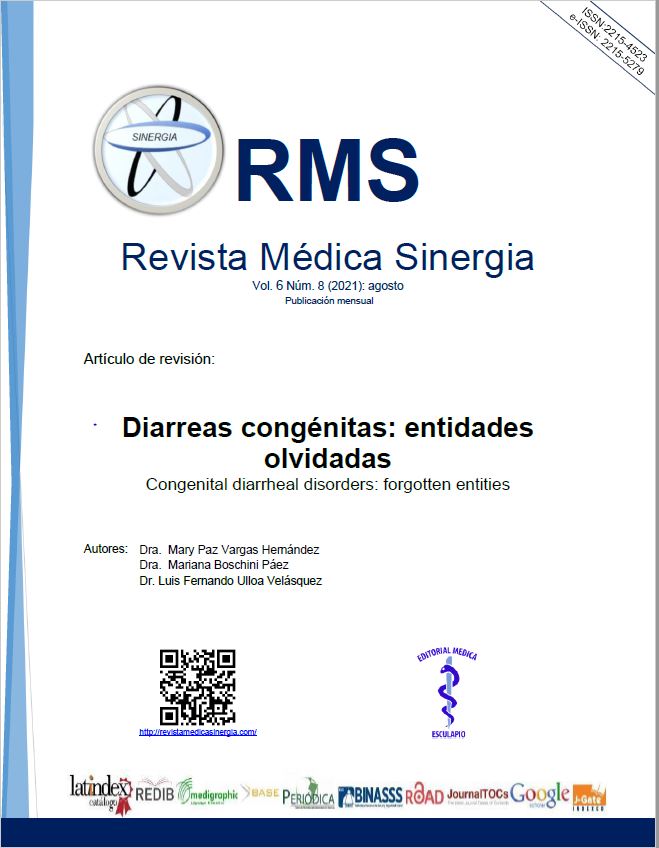Resumen
Las diarreas congénitas son trastornos hereditarios que causan diarrea grave persistente en los lactantes, que a menudo llevan a falla intestinal con desenlace fatal si su diagnóstico no es temprano. Estos trastornos generalmente afectan el epitelio intestinal o sus mecanismos de transporte, ya sea afectando las enzimas digestivas, el sistema inmune o los canales de intercambio de electrolitos. El diagnóstico definitivo de estas enfermedades generalmente incluye estudios genéticos, sin embargo, la biopsia intestinal juega un papel fundamental en la orientación al mismo. Esta revisión presenta un resumen de estas entidades, con énfasis en las más frecuentes a nivel mundial.
Palabras clave
Citas
Ensari A, Kelsen J, Russo P. Newcomers in paediatric GI pathology: childhood enteropathies including very early onset monogenic IBD. Virchows Arch. 2018;472(1):111–23.
Dimitrov G, Bamberger S, Navard C, Dreux S, Badens C, Bourgeois P, et al. Congenital Sodium Diarrhea by mutation of the SLC9A3 gene. Eur J Med Genet. 2019;62(10):1–4.
Schlegel C, Lapierre LA, Weis VG, Williams JA, Kaji I, Pinzon-Guzman C, et al. Reversible deficits in apical transporter trafficking associated with deficiency in diacylglycerol acyltransferase. Traffic. 2018;19(11):879–92.
Thiagarajah JR, Kamin DS, Acra S, Goldsmith JD, Roland JT, Lencer WI, et al. Advances in Evaluation of Chronic Diarrhea in Infants. Gastroenterology. 2018;154(8):2045-2059.e6.
Younis M, Rastogi R, Chugh A, Rastogi S, Aly H. Congenital Diarrheal Diseases. Clin Perinatol. 2020;47(2):301–21.
Das B, Sivagnanam M. Congenital Tufting Enteropathy: Biology, Pathogenesis and Mechanisms. J Clin Med. 2020;10(1):19.
Leblanc C, Schlegel C, Robinson JR, Thomsen K, James R, Acra S, et al. The Financial Burden of an Undiagnosed Congenital Diarrhea
Disorder. HHS Public Access. 2020;71(2):145–6.
Xu L, Gu W, Luo Y, Lou J, Chen J. DGAT1 mutations leading to delayed chronic diarrhoea: a case report. BMC Med Genet. 2020;21(1):1–7.
Kamal N, Khan H, El-Shabrawi M, Sherief L. Congenital chloride losing diarrhea A single center experience in a highly consanguineous population. Medicine (Baltimore). 2018;98(22):1–9.
Gluchowski NL, Chitraju C, Picoraro JA, Mejhert N, Pinto S, Xin W, et al. Identification and characterization of a novel DGAT1 missense mutation associated with congenital diarrhea. J Lipid Res. 2017;58(6):1230–7.
Comegna M, Amato F, Liguori R, Berni Canani R, Spagnuolo MI, Morroni M, et al. Two cases of microvillous inclusion disease caused by novel mutations in MYO5B gene. Clin Case Reports. 2018;6(12):2451–6.
Dhekne HS, Pylypenko O, Overeem AW, Ferreira RJ, van der Velde KJ, Rings EHHM, et al. MYO5B, STX3, and STXBP2 mutations reveal a common disease mechanism that unifies a subset of congenital diarrheal disorders: A mutation update. Hum Mutat. 2018;39(3):333–44.
Schoen K, Puchi A, González I, Torres MT, Espinosa R, González R. Microvillous inclusion disease as a cause of severe congenital diarrhea. Case report. Rev Chil Pediatr. 2017;88(5):662–7.
Martin BA, Kerner JA, Hazard FK, Longacre TA. Evaluation of intestinal biopsies for pediatric enteropathy: A proposed immunohistochemical panel approach. Am J Surg Pathol. 2014;38(10):1387–95.
Goldenring JR. The challenge of personalized cell biology: The example of microvillus inclusion disease. Traffic. 2020;21(1):169–71.
van Rijn JM, Ardy RC, Kuloğlu Z, Härter B, van Haaften-Visser DY, van der Doef HPJ, et al. Intestinal Failure and Aberrant Lipid Metabolism in Patients With DGAT1 Deficiency. Gastroenterology. 2018;155(1):130-143.e15.
Gujrati K, Jamila Rahman A, Gulsher. Congenital chloride losing diarrhoea. J Pak Med Assoc. 2014;64(3):339–41

Esta obra está bajo una licencia internacional Creative Commons Atribución-NoComercial 4.0.
Derechos de autor 2021 Array


